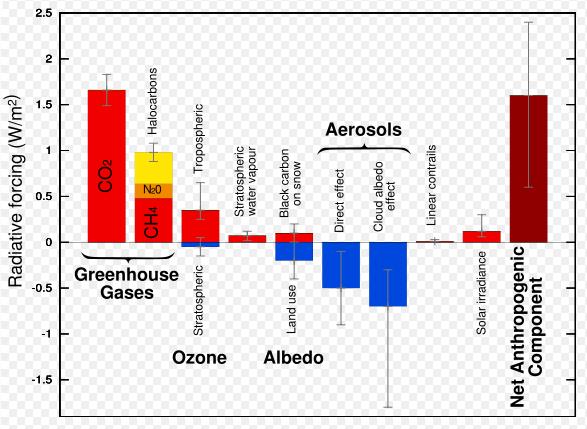Radiative forcing (RF) describes the difference
between the energy that is gained by Earth and then later lost to space. The IPCC uses radiative forcing with
assessments, “to denote an externally imposed perturbation in the radiative
energy budget of Earth’s climate system, which may lead to changes in climate”
(Braun, 2013). Greenhouse gas
concentration can change and cause a disturbance in the radiative forcings that
are calculated. It is used to assess and
compare natural and human related drivers of climate change. It ranks and quantifies the different
influences of climate change but doesn’t represent overall climate responses
(IPCC, 2007).
Radiative forcing can be related to the
greenhouse effect as well, both natural and human enhanced. The imgage belshows a number of radiative forcing
drivers, the first two bars, both red, are greenhouse gases, mainly driven by
human forces. Both of these have a large
radiative forcing affects. CO2
emissions cause an increase of RF. This
is due to the fact that carbon dioxide influences the amount of heat that is
captured within the atmosphere. The more
heat that is captured due to that specific greenhouse gas, which is influenced
by human activities such as driving cars, the higher the radiative forcing bar
for that driver. The third bar that is
shown depicts ozone RF, depending on the good or bad ozone there is either a
negative or positive RF, which can also be affected by human activities.
 |
| A simple graph showing the components of radiative forcing. Bars in red show where heat is added while bars in blue show cooling influences. Heating affects have positive values, while cooling affects have negative values. |
Braun, Carsten. 2013.
The Concept of Radiative Forcing.
Handout.
IPCC. 2007. "2.2
Concept of Radiative Forcing - AR4 WGI Chapter 2: Changes in Atmospheric
Constituents and in Radiative Forcing." IPCC - Intergovernmental Panel
on Climate Change. N.p., n.d. Web. 22 Feb. 2013.
<http://www.ipcc.ch/publications_and_data/ar4/wg1/en/ch2s2-2.html>.
No comments:
Post a Comment